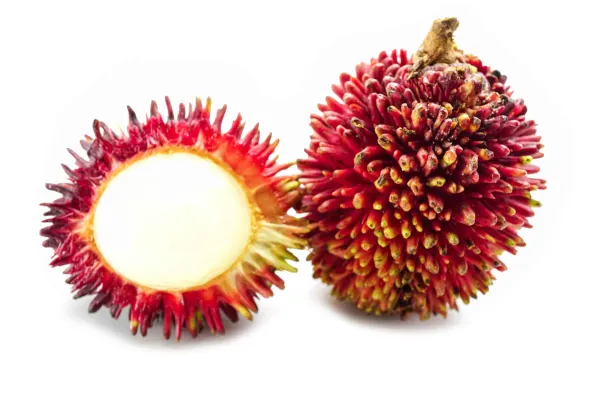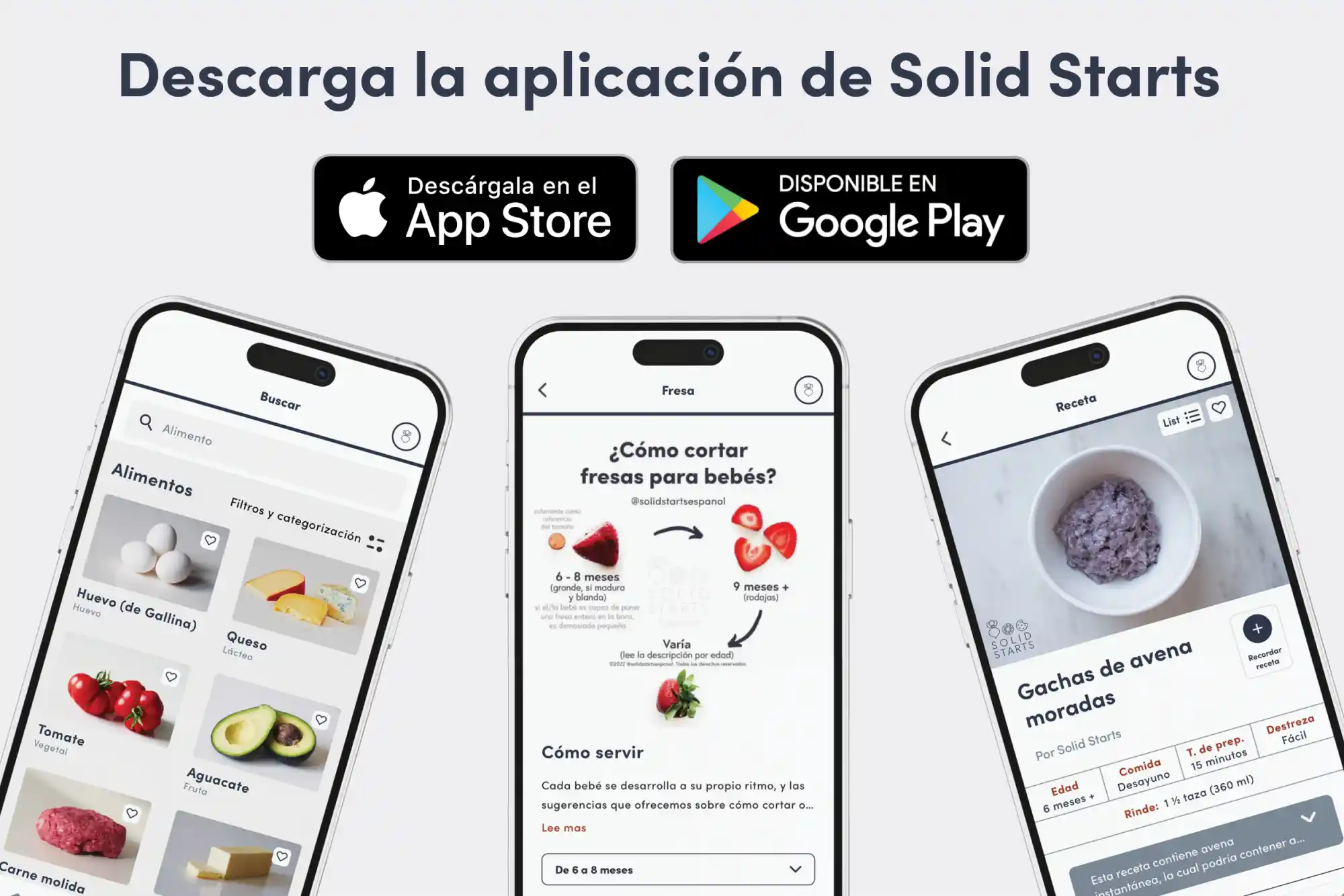Acceda a la base de datos First Foods® en Solid Starts App.
Leer másPulasán
Fruta
Sugerencia de edades
6 meses
Alto contenido de hierro
No
Alérgeno común
No

When can babies have pulasan?
¡Lo sentimos, esta página aún no está disponible en español! Estamos trabajando tan rápido como podemos para traducir todo nuestro contenido, gracias por tu paciencia y apoyo.
Pulasan may be introduced as soon as baby is ready to start solids, which is generally around 6 months of age. Both the flesh of the pulasan and the seed inside pose a choking risk, so see our suggestions for how to serve pulasan by baby’s age before introducing.
Pulasan is a close relative of the rambutan, both juicy fruits of evergreen trees that originated in Southeast Asia. The plant thrives wherever the weather is warm and wet, like the tropics of the Americas, Africa, the Pacific Islands, and Asia, where pulasan is also known as bulala and ngoh khao san, among other names. In Malay, its name means “twist,” which hints at how one eats the fruit.
How do you serve pulasan to babies?
Cada bebé se desarrolla a su propio ritmo, y las sugerencias que ofrecemos sobre cómo cortar o preparar determinados alimentos son generalizaciones para una amplia audiencia.
6 months old +:
Finely chop fresh pulasan, seed and shell removed, and serve atop a soft, scoopable food like congee, mashed plantains, or yogurt.
9 months old +:
Discard the seed and shell and cut the pulp into quarters to create bite-sized pieces (about the size of a large adult knuckle). Serve the pieces of pulasan on their own for the child to practice picking up or mix them into grains or fruit salads. Of course, you may continue to finely chop the pulp as well.
3 years old +:
If you feel the child is ready (they can follow directions, chew foods thoroughly, and don’t overstuff their mouth) and you’re okay taking the risk, consider serving a whole pulasan with shell removed, first modeling how to take bites from the whole fruit yourself. Bite into the pulasan, tearing off one half. Say, “My teeth hit the hard seed.” Turn the fruit around to show the seed to the toddler. Tap it and explain, “Look, there is a hard seed in here.” Then, pull the seed out and show it to the toddler, saying “We don’t eat this part.” Dramatically toss the seed into the trash. Offer a whole, shelled pulasan to the toddler and say, “you try.” You can try to hold on to the fruit while they take their first bite, but know they may get the whole fruit in their mouth anyway.
If the toddler inadvertently puts the whole fruit, including the seed, in their mouth, step one: do not panic. Kneel next to the toddler and demonstrate sticking your tongue out and say: “Spit that out please.” Put your hand under their chin while you demonstrate. If needed, put a fruit in your own mouth, show it on your tongue, then demonstrate spitting it into your own hand.
¡Lo sentimos, esta página aún no está disponible en español! Estamos trabajando tan rápido como podemos para traducir todo nuestro contenido, gracias por tu paciencia y apoyo.
Is pulasan a choking hazard for babies?
Yes. Pulasan is chewy, firm, and slippery, qualities that increase the risk of choking. The pulasan’s inner seed is edible, but it is hard and rounded, making it a high choking risk as well. To reduce these risks, remove the shell and seed, and prepare and serve pulasan in an age-appropriate way. As always, make sure you create a safe eating environment and stay within an arm’s reach of baby during meals. For more information on choking, visit our sections on gagging and choking and familiarize yourself with the list of common choking hazards.
Is pulasan a common allergen?
No. Allergies to pulasan are rare, but possible. People who are allergic to pollens may be sensitive to pulasan, rambutan, and lychee fruits, as can individuals with Oral Allergy Syndrome (also known as pollen-food allergy). Oral Allergy Syndrome typically results in short-lived itching, tingling, or burning in the mouth and is unlikely to result in a dangerous reaction.
As you would when introducing any new food, start by offering a small quantity for the first few servings. If there is no adverse reaction, gradually increase the quantity over future meals.
Is pulasan healthy for babies?
Yes. Pulasan is packed with plenty of calcium to support bone health and potassium as an important electrolyte for heart health. It also offers a good amount of vitamin C, which aids the absorption of plant-based sources of iron. The benefits don’t stop there: the fruit also offers antioxidants to repair cells, carbohydrates for fast energy, and fiber to nourish baby’s developing gut microbiome.
¿Qué hago si mi bebé no quiere comer?
Termina la comida y ofrécele una toma de pecho o biberón. Nunca presiones a un/a bebé o a un/a niño/a para que coma; a largo plazo esto sólo empeorará el rechazo a los alimentos. Los bebés rechazan la comida por diferentes motivos, como la dentición, una enfermedad, demasiado cansancio, o falta de energía o interés en aprender una nueva habilidad. Para obtener más información sobre por qué el/la bebé puede negarse a comer, consulta nuestra guía Cómo responder al rechazo de los alimentos en los bebés.
¿Cuáles son algunos ejemplos de alimentos con los que puedo comenzar?
Hay muchos alimentos que pueden ser excelentes opciones. Busca alimentos que permitan que el/la bebé se alimente solo/a fácilmente, que tengan bajo riesgo de ahogamiento y que ofrezcan los nutrientes que los bebés necesitan, como el hierro. Algunos de nuestros primeros alimentos favoritos incluyen brócoli al vapor, avena, y semilla de mango.
Nuestro equipo
Escrito por
- 1.
Malaysian Food Composition Database. Pulasan. Retrieved April 25, 2022
- 2.
Malaysian Food Composition Database. Pulasan. Retrieved April 25, 2022
- 3.
Hairunisa et al. (2021). IOP Conf. Ser.: Earth Environ. Sci. 736 012018. Retrieved April 25, 2022
- 4.
Raap U, Schaefer T, Kapp A, Wedi B. Exotic food allergy: anaphylactic reaction to lychee. Department of Dermatology and Allergology, Hannover Medical University. (2007) Retrieved April 25, 2022
- 5.
Kelso, J. M., Jones, R. T., Yunginger, J. W. (1998). Anaphylaxis after initial ingestion of rambutan, a tropical fruit. Journal of Allergy and Clinical Immunology, 102, 1, 145-146. DOI: 10.1016/S0091-6749(98)70066-1. Retrieved April 25, 2022
- 6.
Jirapongsananuruk, O., Jirarattanasopa, N., Pongpruksa, S., Vichyanond, P., & Piboonpocanun, S. (2011). Glyceraldehyde-3-phosphate dehydrogenase as a major allergen in rambutan-induced anaphylaxis. Annals of allergy, asthma & immunology : official publication of the American College of Allergy, Asthma, & Immunology, 106(6), 545–547. DOI: 10.1016/j.anai.2011.03.008. Retrieved April 25, 2022
- 7.
Rank, M. A., & Li, J. T. (2007). A case of food allergy due to longan fruit. Annals of allergy, asthma & immunology : official publication of the American College of Allergy, Asthma, & Immunology, 98(4), 402. DOI: 10.1016/S1081-1206(10)60890-3. Retrieved April 25, 2022
- 8.
Raap U, Schaefer T, Kapp A, Wedi B. Exotic food allergy: anaphylactic reaction to lychee. Department of Dermatology and Allergology, Hannover Medical University. (2007) Retrieved April 25, 2022
- 9.
Valsecchi R, Leghissa P. Contact allergy due to Lychee. Departments of Dermatology and Occupational Medicine, Bergamo General Hospital. (2012) Retrieved April 25, 2022
Consejos de expertos directo a tu bandeja de entrada
¡Suscríbete y recibe correos semanales con recetas, consejos y más!
Copyright © 2025 • Solid Starts Inc
Utilizamos cookies para brindarte la mejor experiencia en nuestra página web, como se detalla en nuestra Política de privacidad. Al utilizar este sitio web, usted acepta este uso de cookies.
El contenido que se ofrece en SolidStarts.com y la aplicación Solid Starts es solo para fines informativos y se ha creado pensando en bebés y niños(as) con un desarrollo normal. La información aquí, que incluye pero no se limita a sugerencias sobre cómo cortar o preparar alimentos en particular y el tamaño y la forma de alimentos en particular, se generaliza para una amplia audiencia. Tu hijo(a) es un(a) individuo(a) y puede tener necesidades o consideraciones más allá de las prácticas generalmente aceptadas. Si tu hijo(a) tiene diferencias médicas o de desarrollo subyacentes, te recomendamos enfáticamente y te alentamos a que analices tu plan de alimentación y cuándo y cómo comenzar la alimentación complementaria y a ofrecer bocados con el/la médico(a), el/la profesional de la salud, el/la nutricionista o experto(a) en alimentación y deglución pediátrica de tu hijo(a) (" Proveedores(as) de servicios de salud"). Solid Starts no se dedica a brindar asesoramiento profesional, ya sea médico o de otro tipo, a usuarios individuales o sus hijos(as) o familias. Ningún contenido de este sitio o aplicación móvil, independientemente de la fecha, debe utilizarse como sustituto de los consejos individuales y específicos para niños de tu médico(a) pediatra o profesional de la salud o para el consejo médico directo de sus proveedores de atención médica.
Al usar esta página web o aplicación móvil, reconoces que comprendes que es imposible eliminar por completo todo riesgo de que un(a) bebé o un(a) niño(a) se ahogue con cualquier líquido, puré o alimento. Te recomendamos que sigas todos los protocolos de seguridad que sugerimos para crear un entorno de alimentación seguro y tomar decisiones informadas para tu hijo(a) tomando en cuenta sus necesidades específicas. Nunca ignores el consejo médico profesional ni te demore en buscarlo debido a algo que hayas leído o visto aquí.
Al acceder al contenido de SolidStarts.com o de nuestra aplicación móvil, reconoces y aceptas que aceptas la responsabilidad por la salud y el bienestar de tu hijo(a). A cambio de que Solid Starts te brinde una variedad de contenido sobre "BLW", niños(as) pequeños(as) y la alimentación quisquillosa, tú renuncias a cualquier reclamo que tú o tu hijo(a) puedan tener como resultado de utilizar el contenido que brinda Solid Starts. Siempre busca el consejo de tus proveedores(as) de atención médica con cualquier pregunta que puedas tener sobre el desarrollo y la capacidad de tu hijo para comenzar la alimentación complementaria.







